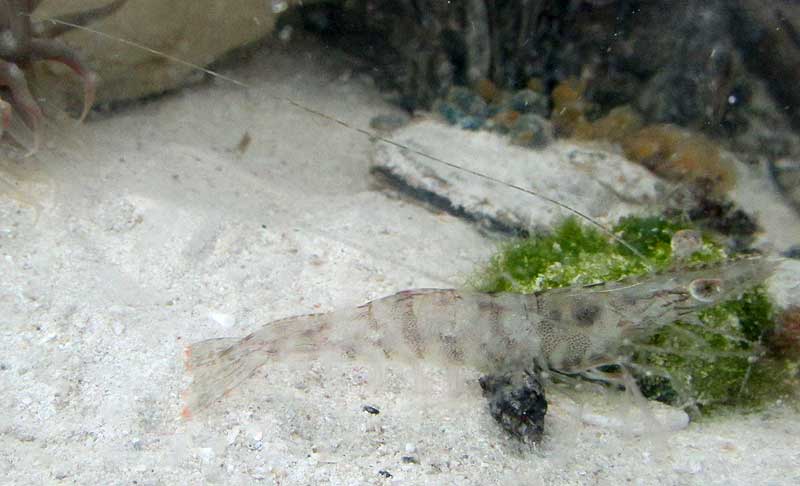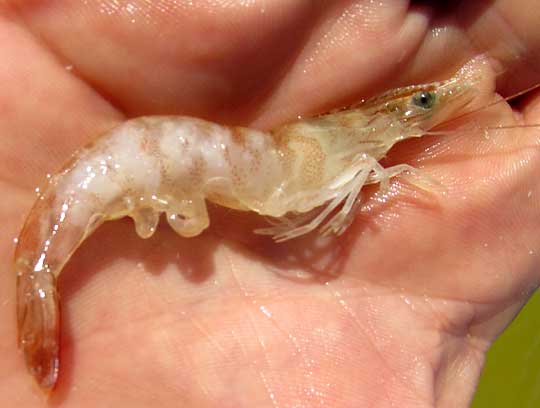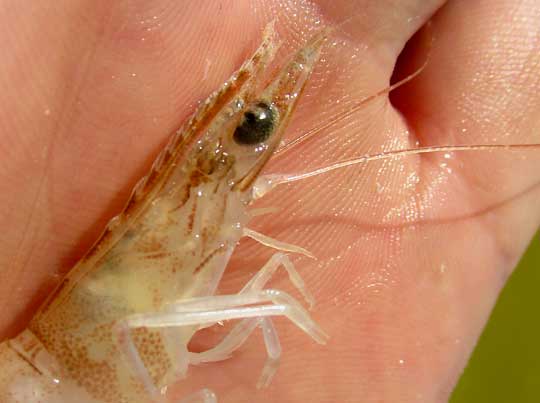Excerpts from Jim Conrad's
Naturalist Newsletter

from the March 22, 2015 Newsletter issued from Río Lagartos, on the Yucatan Peninsula's northern coast (~N21.60°, ~W88.16°), Yucatán state, MÉXICO
PINK SHRIMP
During the night's early hours along Río Lagartos's Malecón -- the broad, estuary-side avenue on the town's western, northern and eastern shores -- usually atop the knee-high, stone storm-wall you find local folks with flashlights and long-handled dip-nets seining the waters at the wall's base. After being dragged through the water a few feet normally when the net is pulled up it contains a few shrimp jumping around trying to escape. The shrimp are dumped into a plastic bucket on the sidewalk. Half an hour of seining might catch enough for a family to eat all the shrimp they want for a day or two. Here a kind of shrimp soup is popular, and a dish called ceviche.
One night my friends Rayo and Jorge also got a flashlight and long-handled dip-net, and went seining from atop the Malecón's storm wall. They seined for just a few minutes, though, for all they wanted were a few shrimp for the aquarium they were setting up. At the top of this page you can see one of the pale, well camouflaged shrimp they caught, whose body was about 1¾ inches long (45mm), exploring the aquarium's sandy floor.
Such shrimp usually are referred to as camarónes rosados, or pink shrimp, even though ours from along the Malecón's storm wall weren't very pink. Three pink shrimp species are listed for Ría Lagartos Biosphere Reserve, so which was this? It was harder to figure that out than I'd expected, one main reason being that our red shrimp were juveniles. It's a feature of red shrimp natural history that immature ones gather in estuaries such as ours, where they feed relatively safely among seagrass stems and leaves in shallow water. As pink shrimp grow, they look for more and more saline areas, eventually leaving their nursery-estuaries and returning to begin lives in the sea.
Of the three red shrimp species occurring in Ría Lagartos Estuary, Penaeus notialis is mainly found on the Yucatán's eastern, Caribbean Coast, so we're a little beyond their main distribution area, and that species is less common here. Another species, Penaeus brasiliensis, is common in the area, but tends to be much redder than our aquarium individual. The third species, PENAEUS DUORARUM, seems to be what we have, a species whose center of distribution is the Gulf of Mexico, though it's found from Maryland on the eastern US coast south to the Yucatan Peninsula. Sometimes all three of these species are placed in the genus Farfantepenaeus, but that's controversial, and often the name is presented as Penaeus (Farfantepenaeus) duorarum. Sometimes the species is called the Northern Pink Shrimp.
Females of Northern Pink Shrimp can reach 11 inches long (28cm) in length, so our 1¾-inch one (4.5cm) is small. The preferred habitat of adults who have left their nursery estuaries is between ±35-120 feet deep (11-36m), where they live on firm mud and silt with sand and shells.
Though local fishermen assure me that the estuary is full of pink shrimp, on flamingo-viewing trips you seldom see them, for they stay well hidden in seagrass on the estuary's floor. However, this week I did find one along shore in water hardly a finger-width's deep, in a tangle of Widgeongrass at very low tide. The shrimp was so lethargic and its eyes were so clouded that it seemed to be almost dead for some reason, but I still took its picture, shown below:

The pale bands of pink stipples around its abdomen are typical of the species. I read that when Northern Pink Shrimp are cooked, their shells turn a deeper shade of pink than other species, and their meat turns from translucent to pink. A close-up of this individual's head appears below:

The serrated crest atop the head extending beyond the eyes is known as the "rostrum" and is typical of pink shrimp species. As individuals grow, the rostrum becomes more impressive. Trying for a picture of the creature's bulbous eyes I got what's shown below:

When that picture came onto the computer screen I was amazed because it's clear that the top of the head is split open, with the head cavity being empty. Yet, in my hand the shrimp definitely had moved around, albeit slowly. Then it dawned on me that surely our shrimp was molting -- in the process of abandoning its old exterior skeleton, or "exoskeleton," so could grow into a new exoskeleton that would harden around it. Our shrimp was in the process of withdrawing his head from the front part of the old exoskeleton and probably was about to buckle inside the old covering, rip through the exoskeleton back, and begin a new stage of life as a somewhat larger shrimp.
But, back to the bulging eyes. The reason for their bulging had become apparent the moment we first dropped the Malecón storm-wall ones into the aquarium. Landing on the aquarium's floor, they immediately began furiously thrashing their legs, stirring up currents of swirling sand, and causing their bodies to sink into the cavities below them formed by the whipped-up sand. Within seconds their entire bodies had sunk into the sand, leaving only their bulging eyes poking above the sand's surface. Shrimp eyes bulge so the shrimp can see what's happening around them when their bodies are buried in sand.
According to the United Nation's FAO agency, in 1977 the total world catch of Penaeus duorarum reached a peak with 23,237 tons. Since then the catch has gone into a general decline, presumably because of overfishing and habitat destruction (especially of mangrove-bordered estuaries such as Ría Lagartos). In 2012 the catch was only 4522 tons.